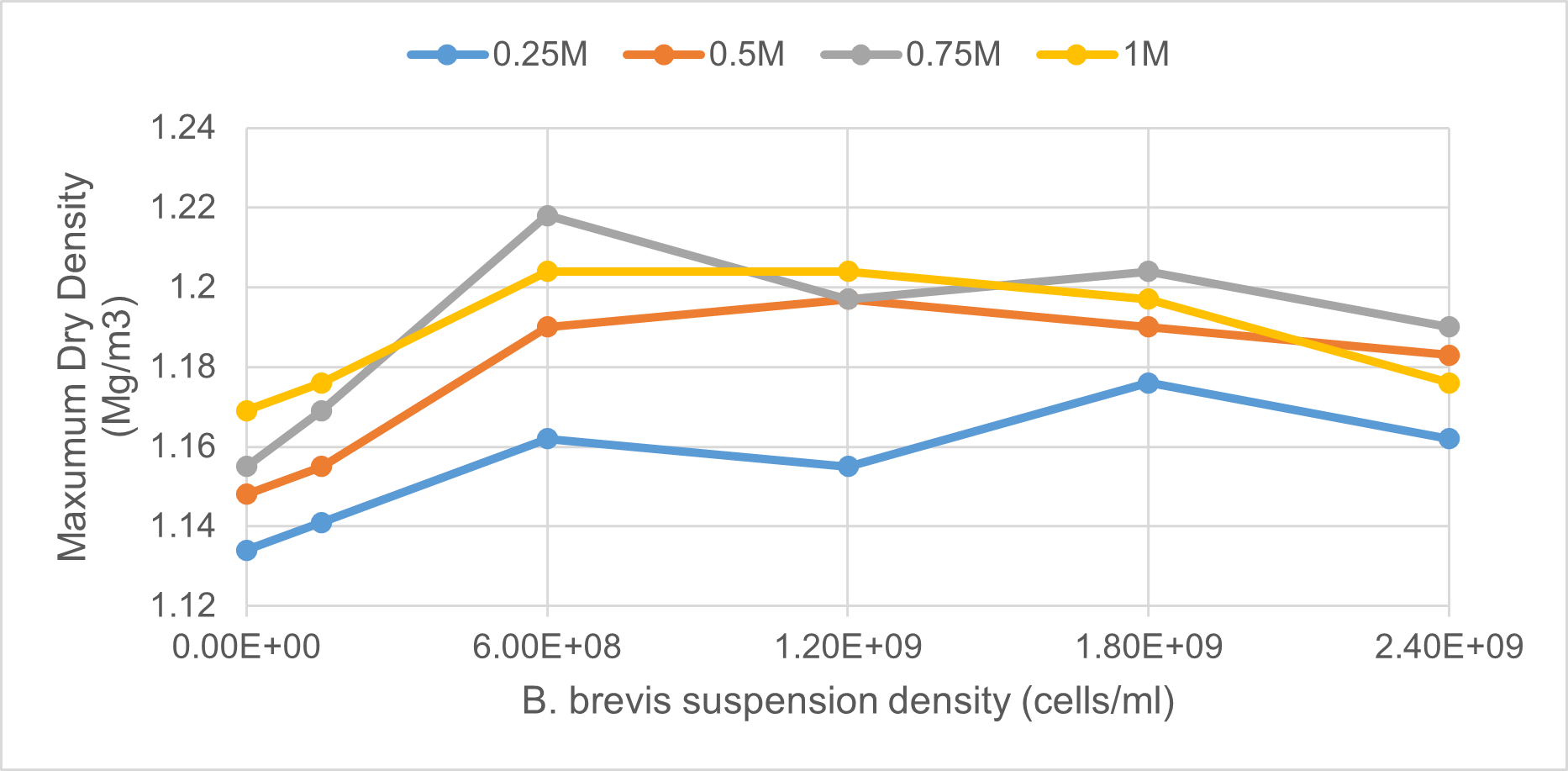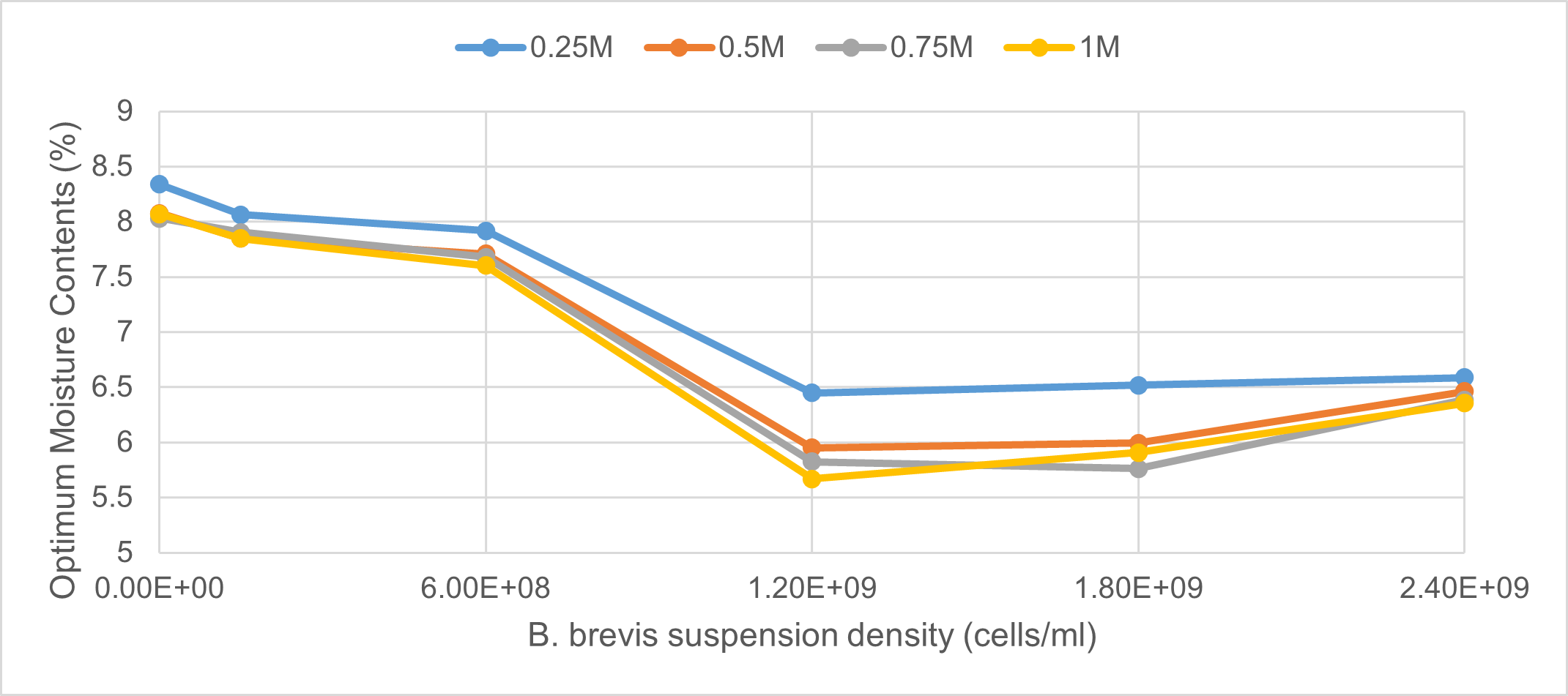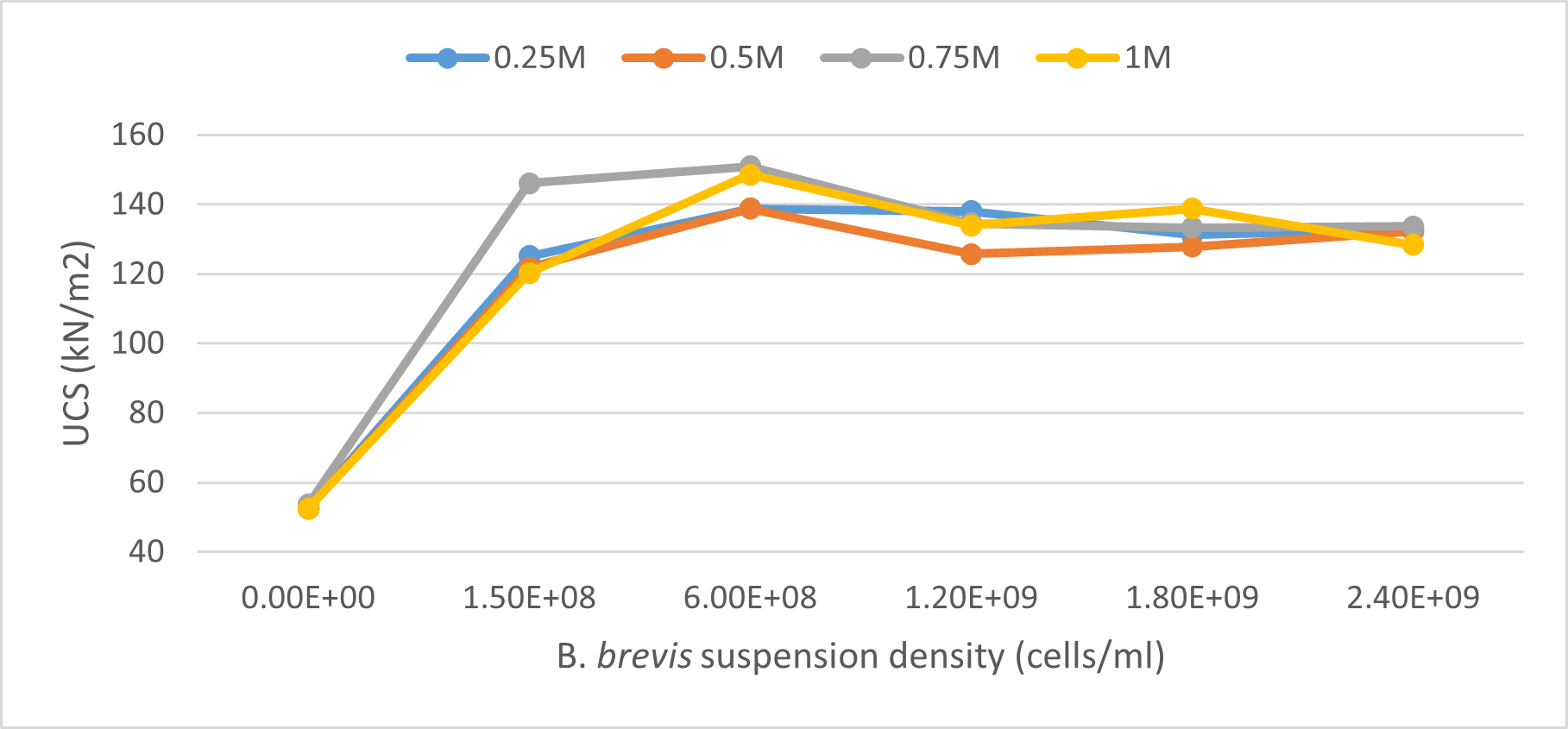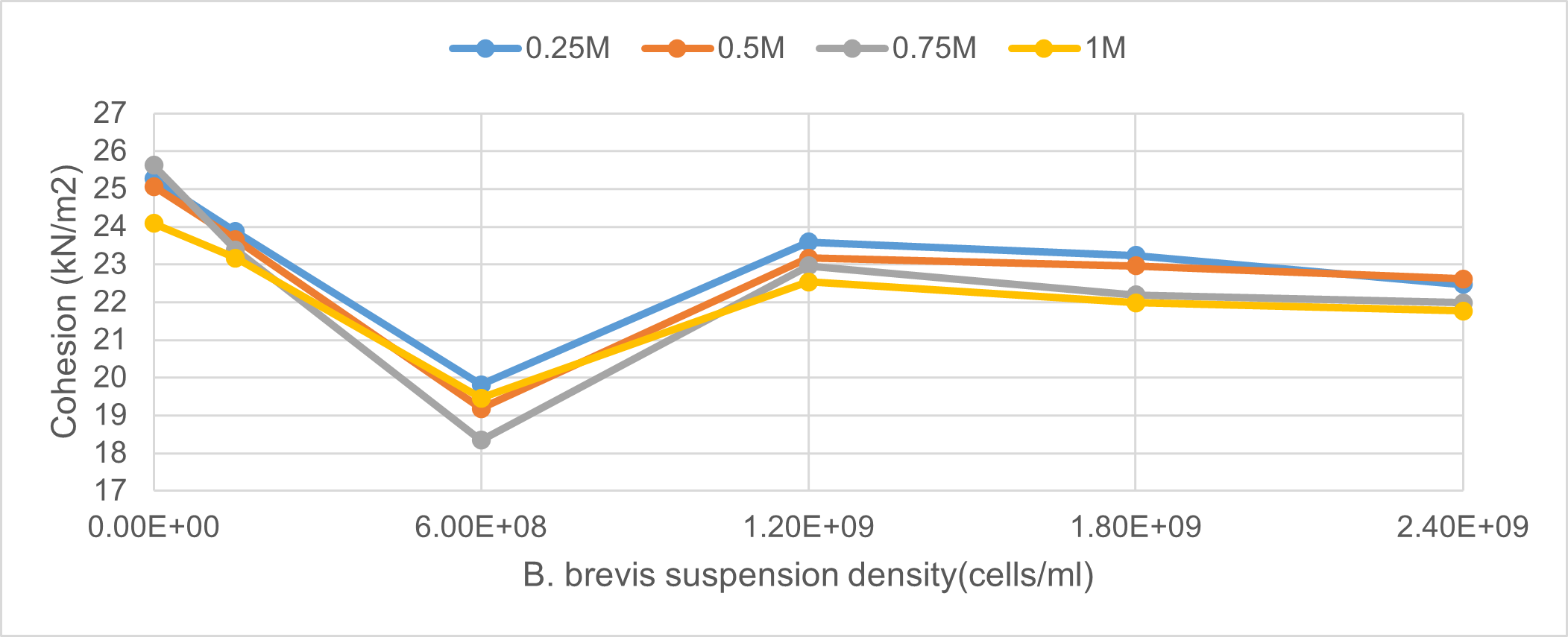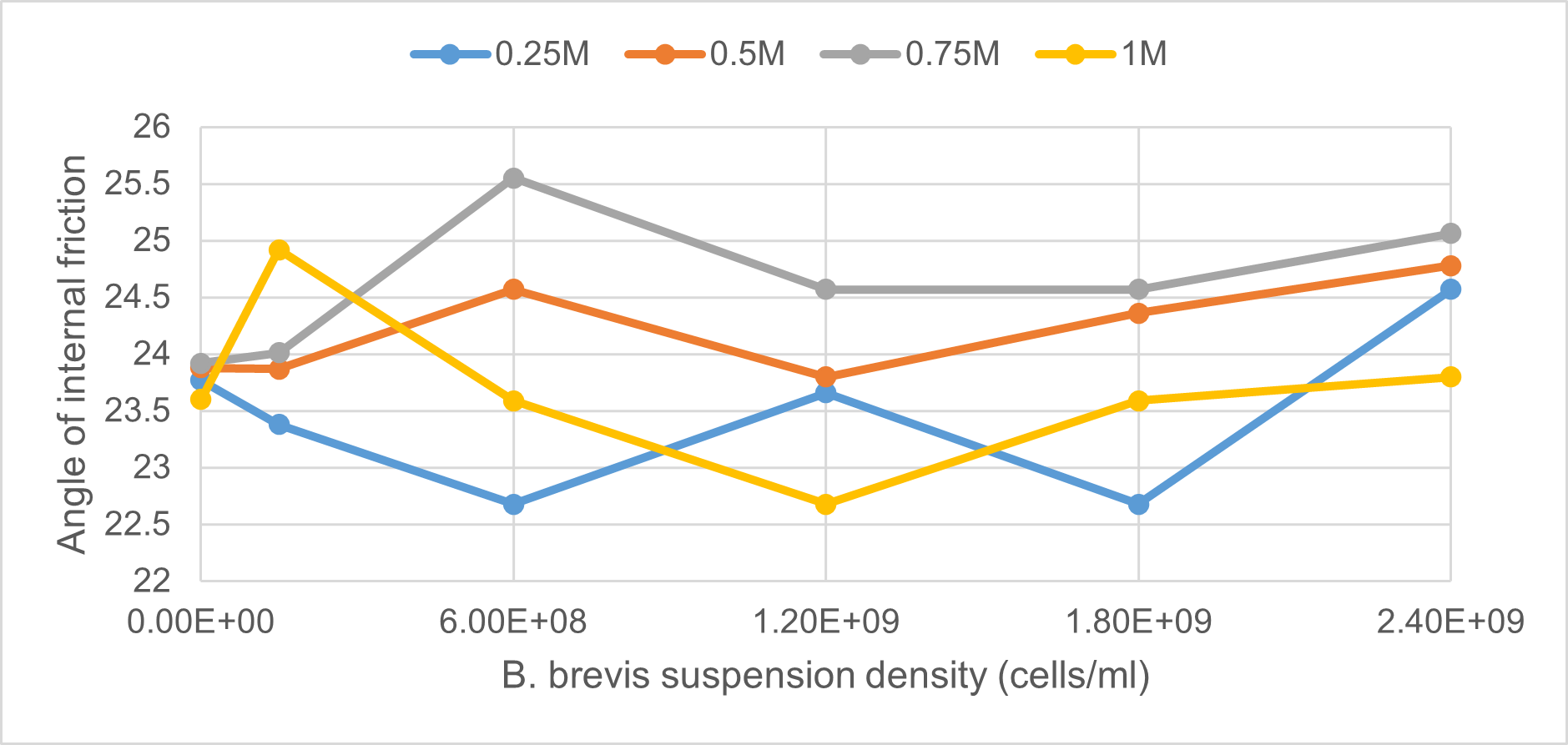Microbial Induced Calcite Precipitate Improvement of Aeolian Soil for Use as a Construction Material
- A. M. Garba
- K. J. Osinubi
- A. O. Eberemu
- T. S. Ijimdiya
- M. Abubakar
- 438-447
- May 23, 2024
- Microbiology
Microbial Induced Calcite Precipitate Improvement of Aeolian Soil for Use as a Construction Material
A. M. Garba1, K. J. Osinubi2, F. ASCE, A. O. Eberemu3, M. ASCE, T. S. Ijimdiya2, M. ASCE and M. Abubakar1
1Professor, Ahmadu Bello University Zaria, Kaduna State, Nigeria,
2Professor, Ahmadu Bello University and Africa Center of Excellence on New Pedagogies in Engineering Education (ACENPEE), Kaduna State, Nigeria,
2Professor, Ahmadu Bello University Zaria, Kaduna State, Nigeria,
1Graduate student, Ahmadu Bello University Zaria, Kaduna State, Nigeria,
DOI: https://doi.org/10.51584/IJRIAS.2024.904032
Received: 14 November 2023; Accepted: 08 December 2023; Published: 23 May 2024
ABSTRACT
An environmentally friendly and successful technique of soil improvement known as Microbial Induced Calcite Precipitation (MICP) has attracted the attention of geotechnical engineers. This study was conducted to modify the engineering behaviour of an aeolian soil bio-treated with Bacillus brevis (B. brevis) to evaluate its suitability for use in construction works. Stepped B. brevis suspension density (i.e., 0.5, 2.0, 4.0, 6.0 and 8.0 McFarland standards equivalent to 0, 1.50 × 108, 6.0 × 108, 1.20 × 109, 1.80 × 109 and 2.40 × 109 cells/ml, respectively) and cementation reagent (i.e., 0.25, 0.5, 0.75 and 1.0 M), respectively, were utilized to activate the MICP process. Compaction was conducted using British Standard light (BSL) (or standard Proctor) energy. Tests results indicate that the engineering behaviour of the bio-treated non-plastic aeolian silt soil improved. The maximum dry density (MDD) and the angle of internal friction values marginally increased, while cohesion and optimum moisture content (OMC) decreased with higher B. brevis suspension density and cementation reagent concentration. Peak angle of internal friction and minimum cohesion were recorded at 1.5 x 108 cells/ml. Highest unconfined compressive strength (UCS) value of 215.58 kN/m2 was obtained for specimen treated with 25 % B. brevis (6.0 × 109 cells/ml): 75 % cementation reagent (0.75 M) mix ratio. The results recorded show that the improved aeolian soil could be used in engineering works.
Keywords: Aeolian soil, Bacillus brevis, Microbial-induced calcite precipitate, unconfined compressive strength
INTRODUCTION
Recently, a new soil treatment technique to control erosion was developed. The technique is sustainable and environmentally friendly and is used to improve soil engineering behaviour such as strength, durability and porousness (DeJong et al., 2010; Osinubi et al 2018; Osinubi et al 2019; Osinubi et al 2020). The method is called Microbial Induced Calcium Carbonate Precipitate or Microbial Induced Calcite Precipitation (MICP) and it is a biologically natural method. Urea hydrolyzing bacteria are mostly used in most applications of MICP. The technique is very simple, long-lived, low cost as well as efficient and there is no excess proton production (Whiffin et al., 2007; Armstrong et. al., 2021)
Soil improvement methods need to be sustainable and environmentally friendly. Industrial soil improvement additives such as Portland cement, lime, asphalt and sodium silicate have been successfully used in soil enhancement (Karol, 2003; Basha et al., 2005). However, the injection of industrially produced chemicals often alters the pH level of soil, contaminates soil and groundwater due to their toxic and hazardous nature (Karol 2003; DeJong et al., 2006). Therefore this study was focused on the use of MICP technique to improve the engineering properties of an aeolian soil with low unconfined compressive strength (UCS).
MATERIALS AND METHODS
Materials
Soil
The aeolian silty soil used in this study was collected from Wudil Local Government Area (11o47’39.2712” N and 8o50’20.5152” E), Kano state, Nigeria. The soil sample were collected by method of disturbed sampling at a depth of 15 cm so as to minimise organic materials. The soil samples were placed in a clean polythene bag and transported to Ahmadu Bello University, Zaria, Kaduna State, where they were stored at laboratory room temperature of 25 ± 2° C.
Microorganism
The microorganisms used in this study is B. brevis, which was isolated from the natural soil. The urease positive microbe is rod-shaped, spore-forming and Gram-positive.
Cementation reagent
The cementation mixture consisted of 20 g Urea, 10 g NH4Cl, 3 g Nutrient broth, 2.8 g CaCl4 and 2.12 g NaHCO3 per litre of disinfected water, which has been used in numerous studies (e.g., Stocks-Fischer et al., 1999; Dejong et al., 2006; Al Qabany et al., 2011; Park et al., 2014; Tirkolaei and Bilsel, 2017). In all the cited studies, 3 g/l of nutrient broth was extra to the cementation mixture since it is the most practical amount for survival of the microbes (Sharma and Ramkrishnan, 2016). However, the constituent was varied to obtain diverse concentrations such as 0.25, 0.5, 0.75 and 1.0M.
Methods
Microbes isolation, culture/growth medium Isolation of B. brevis
The culture of B. brevis from soil was done by the tyrosine selection method as described by Edwards and Seddon (2000). For all samples, 10 g aeolian soil was extracted to 90 mL of disinfected water and raised for 45 minutes at 28o C on a rotatory shaker (B. Bran scientific & instrument company, England) at 250 rpm. Thereafter, 2 mL of the broth culture was added to 20 mL of sterile Tyrosine broth that consisted (g/l) of disinfected water, 6.5 g/l nutrient broth and 5.0 g/l tyrosine; they were then autoclaved at 121o C for 15 min in 50 mL Erlenmeyer flask. The solution was rinsed for 4 hours at 28o C on a rotatory shaker at 250 rpm. After incubation, 5 mL aliquots from all culture were placed in hot water bath operating at 80o C for 3 minutes. And then 0.1 mL was spread on Tyrosine agar (Nutrient broth 6.5 g/L, tyrosine 5 g/L and Agar 15g/L) and incubated at 28oC for 24 hours. After 24 hours of incubation, bacterial clusters on the dishes were visually examined. Colonies showing morphological features such as being light brown, non-spreading, serrated edges and clear halos typical for the B. brevis, were sub-cultured on Tyrosine agar.
Identification of B. brevis
The cultural and biochemical characteristics of the isolates were used for a presumptive characterization of the B. brevis (Cowan and Steel, 2003; Bergey, 2004) and then confirmed based on the retention factor (RF) on the thin layer chromatography plate as compared to the standard (Gramicidin).
Compaction
The air-dried soil sample passing British Standard (BS) sieve with 4.76 mm opening was used. British Standard light, BSL (or standard Proctor) energy was derived from 2.5 kg rammer dropping through 30 cm onto three layers in a 1000 cm3 mould, each getting 27 uniformly spread blows.
MICP Treatment
The soil sample was treated by mixing it with B. brevis (B) suspension densities of 0, 1.5 x 108, 6.0 x 108, 12 x 108, 18 x 108 and 24 x 108 cells/ml, respectively, at 1/3 pore volume consistent with reported by Rowshanbakhta et al. (2016) and the cementation solution (C). The treated samples were then used in preparing specimens for the strength test.
Unconfined compressive strength
The compacted bio-treated specimens were extruded from the 1,000 cm3 compaction moulds using a cylinder-shaped core cutter with a height of 76.2 mm and internal diameter of 38.1 mm. The specimens were cured for 24 h at a laboratory temperature of 25 ± 2 °C to improve calcite development within the soil before being wrapped in polythene bags for 7 days being the curing period. Subsequently, the specimens were positioned in a load frame driven at a constant strain rate of 0.10 %/min until failure occurred. Three different samples were used for each test and the average results was recorded.
RESULTS AND DISCUSSION
Index Properties of the Natural Soil
The natural soil had a moisture content of 27.0 % as at the time of sampling due to the rainy season. The physical properties of the soil sample are summarized in Table 1. The particle size distribution curve is presented in Figure 1. The soil is brownish in colour; it is non-plastic in nature and has 3.0 % fines passing through sieve No. 200. It is classified as A-3(0) soil group using the AASHTO system of soil grouping (AASHTO, 1986) and sandy silt (SM) by the Unified Soil Classification System (ASTM, 1992). In their natural state, aeolian soils are loose materials and lack cohesiveness which tends to hamper their strength and makes them unsuitable for most engineering projects such as pavement construction and building foundations. The aeolian soil used in this study was adjudged as poorly graded sand having 38 % of its particles finer than No. 200 sieve aperture. Therefore, it requires improvement in order to be used in engineering works.
Figure 1. Particle size distribution curve of the natural aeolian soil.
Table 1. Properties of the natural aeolian soil used in the study
| Property | Quantity |
| Percentage passing No. 200 sieve | 38.0 |
| Natural Moisture Content, % | 27.0 |
| Liquid Limit, % | – |
| Plastic Limit, % | Non-plastic |
| Plasticity Index, % | Non-plastic |
| Linear Shrinkage, % | – |
| Specific Gravity | 2.63 |
| AASHTO Classification | A-3(0) |
| USCS Maximum Dry Density, Mg/m3 | SP-SM 1.62 |
| Optimum Moisture Content, % | 2.0 |
| Colour | Brown |
Compaction Characteristics
Maximum dry density
The variation of maximum dry density (MDD) of aeolian silty sand with B. brevis suspension density for varying cementation solution concentration when BSL compaction energy was used is shown in Figure 2. Generally the MDD values initially increased to peak values at B. brevis suspension density of 6 x 108 cells/ml, before reducing with higher B. brevis suspension density and cementation reagent concentration. The highest MDD value of 1.22 Mg/m3 was recorded for soil treated with B (6.0 x 108 cells/ml) – C (0.75 M) mix ratio.
The comparatively high MDD values recorded at B. brevis nucleation site of 6 x 108 cells/ml are symbolic of the development of denser soil mass due to the precipitated calcite that filled the soil pore spaces present in the aeolian soil (De Muynck et al., 2010; Bu et al., 2018; Seifan et al., 2019 and Seifan et al., 2020). Furthermore, the higher MDD values recorded could probably be due to the stable combination between the bacteria and cementation reagent, which triggered the precipitation of more calcite in the specimens.
Figure 2. Variation of maximum dry density of aeolian soil with B. brevis suspension density
Optimum moisture content
The variation of optimum moisture content (OMC) of aeolian soil with B. brevis suspension density is shown in Figure 3. The OMC values recorded initially decreased with increase in B. brevis nucleation site and cementation solution, with the least values recorded at 1.2 x 109 cells/ml before increasing with higher brevis suspension density and cementation solution concentration. The OMC values decreased from a minimum value of 8.0 % (0.75M) for the control (natural soil) to the least values of 5.7 % (1 M) at 12 x 108 cells/ml, before increasing at 24 x 108 cells/ml.
The initial decreasing trend of OMC values might be attributed to the void spaces in the soil being occupied by calcite precipitated through biogeochemical response among the bacteria and the cementation solution that resulted in a decreasing tendency for water absorption (Anbu et al., 2016; Hoang, 2018).
Figure 3. Variation of optimum moisture content of aeolian soil with B. brevis suspension density
Unconfined Compressive Strength
The variation of unconfined compression strength (UCS) of the aeolian silty sand prepared at OMC with Bacillus brevis suspension density is presented in Figure 4. Generally, the UCS values increased with increase in Bacillus brevis nucleation site and cementation reagent concentration. The highest UCS values were achieved at Bacillus brevis suspension density of 6.0 x 108 cells/ml for all cementation solution concentrations considered. The peak UCS value of 150.91 kN/m2 was obtained for treatment with B (6.0 x 108 cells/ml) – C (0.75 M).
The lower UCS value recorded for the control sample in comparison to the bio-treated specimens could be due to the formation of more calcite, resulting from the introduction of more microbial cells into the treated specimens during the MICP process. Therefore, a larger population of microorganisms, which implies more accessible nucleation sites, frequently leads to increased urease activity and, as a result, an increase in calcite precipitation (Soon et al., 2012; Osinubi et al., 2019 b and b; Osinubi et al., 2020; Sani et al., 2020)
The observed reduction in UCS values after the peak values were attained for the treated specimens could be attributed to the low volume of cementation reagent when associated to the microbial population in those nucleation sites. As reported by Anbu et al. (2016), the capacity of cementation solution and cell absorption in a particular microbial solution density has a significant impact on urea hydrolysis. It implies that, the volume of cementation reagent given to the nucleation sites with greater cell concentrations was insufficient to produce enough calcium carbonate to improve the connection and strength of the bio-treated soil mass (Soon et al., 2012; Osinubi et al., 2019a).
Figure 4. Variation of unconfined compressive strength (7 days curing) of aeolian soil with B. brevis suspension density
Cohesion
The variation of cohesive of Aeolian soil with B. brevis suspension density is shown in Fig. 4. The cohesive values initially decreased to minimum values at B. brevis suspension density of 6 x 108 cells/ml and thereafter increased at 12 x 108 cells/ml and decreased thereafter with higher bio-treatment. The results recorded showed a marginal improvement in the cohesion of the Aeolian soil which reduced from 25.27 kN/m2 to 18.34 kN/m2 although the pseudo-coarse particles or transition particles from clay to silt fraction of the Aeolian soil properties were improved by the precipitated calcite. (Sani and Bala, 2021).
Figure 4: Variation of cohesion of aeolian soil with B. brevis suspension density
Angle of Internal Friction
The variation of angle of internal friction of Aeolian soil with B. brevis suspension density is presented in Fig. 5. Particularly the angle of internal friction values increased for cementation reagent concentrations 0.25, 0.5 and 0.75 M with increase in B. brevis suspension density, but decreased with higher B. brevis suspension density and for cementation solution concentration of 1.0 M. The peak angle of internal friction of 25.6o was recorded at 6.0 × 108 cells/ml.
The increase in angle of internal friction value recorded can be attributed to the role of the precipitated calcite within the soil during MICP process. The ureaze enzyme generated the MICP biochemical response, by hydrolyzing urea and the ammonium (NH4+) formed increased the pH which triggered the bicarbonate (HCO3−) to precipitate calcium ion (Ca2+) from the calcium chloride solution. The calcite formed bridged the aeolian soil particles and filled the pores. The calcite crystals were responsible for the bonding between the soil elements and restricted the movement of the soil grains and thereby increased angle of internal friction. (Harkes et al., 2010 ; Mujah et al., 2017 ; Osinubi et al., 2019b and Sani et al., 2020a and b).
Figure 5: Variation of the angle of internal friction of Aeolian soil with B. brevis suspension density
CONCLUSION
The natural aeolian soil classified as A–3 (0) and SP-SM in AASHTO and USCS systems, respectively, was subjected to treatment with cementation reagent only as the control. Specimens bio-treated with B. brevis suspension densities of 1.5 x 108, 6.0 x 108, 1.2 x 109, 1.8 x 109 and 2.4 x 109 cells/ml and cementation solution concentration of 0.25, 0.50, 0.75 and 1.0 M, respectively, and compacted with BSL energy were used in the study. Based on the results obtained the following conclusions can be made:
- The Atterberg limits (i.e., liquid limit, plastic limit and plasticity index) indicated that the soil is non-plastic.
- Compaction characteristics (MDD and OMC) showed that peak MDD value of 1.22 Mg/m3, was recorded for B. brevis (6.0 x 108 cells/ml) and cementation reagent (0.75 M) while the least OMC value of 5.7 % was recorded for 12 x 108 cells/ml and 1.0 M treatment.
- Peak UCS value of 150.91 kN/m2 was recorded for treatment with B. brevis (6.0 x 108 cells/ml) and cementation solution (0.75 M).
The least cohesion value of 18.34 kN/m2 and peak angle of internal friction value of 25.5o were recorded for treatment with B. brevis (6.0 × 108 cells/ml) and cementation solution (0.75 M), while
Based on the results of the study, it is recommended that in order to improve strength, the lateritic soil be bio-treated with B. brevis (6.0 x 108 cells/ml) and cementation solution (0.75 M) be used to improve the aeolian soil considered for use in engineering works.
REFERENCES
- AASHTO (1986). “Standard Specifications for Transport Materials and Methods of Sampling and Testing.” 14th Edition, American Association of State Highway and Transport Officials (AASHTO), Washington, D.C.
- ASTM (1992). Annual Book of Standards Vol. 04.08, American Society for Testing and Materials, Philadelphia.
- Al Qabany A., Soga K. and Santamarina C., (2012). Factors affecting efficiency of microbially induced calcite precipitation. J Geotech Geoenviron Eng 138(8): 992-1001.
- Anbu, P., Kang, C., Shin, Y. and So, J. (2016). “Formations of Calcium Carbonate Minerals by Bacteria and its Multiple Applications.” Springerplus, Springer International Publishing, 5(1): 250. https://doi.org/10.1186/s40064-016-1869-2
- Armstrong I. O, Enzo A. P and Peter M. N.’ ‘Bio-precipitation of calcium carbonate mediated by ureolysis: A review.’ Journal of Environmental Engineering Resources. 2021; 26(6): 200379 https:// doi.org/10.4491/eer.2020.379
- Basha, E. A., Hashim, R. Mahmud, H. B., and Muntohar. A. S. (2005). Stabilization of residual soil with rice husk ash and cement. Construction and Building Materials, 19, no. 6: 448-453.
- Bu, C.; Wen, K.; Liu, S.; Ogbonnaya, U.and Li, L. (2018). “Development of bio-cemented constructional materials through microbial induced calcite precipitation”. Journal of Materials and Structures; ISSN 1359-5997;; Vol. 51(1); pp. 1-11. http://dx.doi. org/ 10.1617/ s11527-018-1157-4
- Bergey K. (2004) Soil Improvement Using Microbial: A Review.” Indian Geotechnical Conference IGC2016, 15- 17 December 2016, IIT Madras, Chennai, India.
- BS 1377 (1990). “Method of Testing Soils for Civil Engineering Purpose.” British Standard Institute, BSI, London.
- Cowan T. B and Steel S. A. (2003) District laboratory practice in tropical countries part 2, 2nd edn. Cambridge University Press, New York.
- Daniel DE, Wu YK (1993) Compacted clay liners and covers for arid sites. J Geotech Eng ASCE 119(2):223–237.
- De Muynck, W., Verbeken, K., De Belie, N. and Verstraete, W. (2010). “Influence of urea and calcium dosage on the effectiveness of bacterially induced carbonate precipitation on limestone.” Ecological Engineering, Vol. 36(2), pp. 99-111. DOI: http://dx.doi.org/10.1016/j.ecoleng.2009.03.025
- DeJong JT, Fritzges MB, Nüsslein K (2006) Microbially induced cementation to control sand response to undrined shear. J Geotech Geoenviron Eng 132:1381–1392.
- DeJong J.T., Mortensen B. M., Martinez B. C., Nelson D. C. (2010) Bio-mediated soil improvement. Ecological Engineering 36(2):197 – 210.
- DeJong JT, Fritzges MB, Nüsslein K (2006) Microbially induced cementation to control sand response to undrined shear. J Geotech Geoenviron Eng 132:1381–1392.
- Edwards K. and Seddon B. K. (2000) Experimental optimisation of various cultural conditions on urease activity for isolated Sporosarcina pasteurii strains and evaluation of their biocement potentials. Ecol Eng 109:65– 75.
- Harkes, M. P., Van Paassen, L. A., Booster, J. L., Whiffin, V. S., and Van Loosdrecht, M. C. M. (2010). “Fixation and distribution of bacterial activity in sand to induce carbonate precipitation for ground reinforcement.” Ecol. Eng., Vol. 36, No. 2, pp. 112-117.
- Hoang, T. P. (2018). Sand and Silty-sand Soil Stabilization Using Bacterial Enzyme-induced Carbonate Precipitation (BEICP). A dissertation submitted to the Department of Civil Engineering, Iowa State University, Ames, Iowa.
- Karol RH (2003) Chemical grouting and soil stabilization, 3rd edn. M. Dekker, New York rice husk ash and cement. Constr Build Mater 19:448–453.
- Mujah D, Shahin MA and Cheng L (2017) Stateof- the-Art Review of Bio-cementation by Microbially Induced Calcite Precipitation (MICP) for Soil Stabilization, Geomicrobiology Journal, 34:6, 524-537, DOI: 10.1080/01490451.2016.1225866
- Osinubi, K. J., Eberemu, A. O., Gadzama, E. W. and Ijimdiya, T. S. (2019a). “Plasticity Characteristics of Lateritic Soil Treated with Sporosarcina Pasteurii in Microbial-Induced Calcite Precipitation Application.” SN Applied Sciences Journal Vol. 1: 829.
- Osinubi, K. J., Sani, J. E., Eberemu, A. O., Ijimdiya, T. S. and Yakubu, S. E.(2019b). ‘Unconfined compressive strength of Bacillus pumilus treated lateritic soil.’ Proceedings of the 8th International Congress on Environmental Geotechnics (ICEG 2018), “Towards a Sustainable Geoenvironment” Edited by Liangtong Zhan, Yunmin Chen and Abdelmalek Bouazza, 28th October – 1st November, Hangzhou, China,c Springer Nature Singapore Pte Ltd., Vol. 3, pp. 410–418, Online:https:// doi.org/ 10.1007/978-981-13- 2227-3_51
- Osinubi, K. J., Sani, J. E., Eberemu, A. O., Ijimdiya, T. S., Yakubu, S. E., (2018). “Unconfined compressive strength of Bacillus Pumilus treated lateritic soil.” Proceedings of the 8thInternational Congress on Environmental Geotechnics, Vol. 3, pp 410 – 418.
- Osinubi, K. J., Sani, J. E., Eberemu, A. O., Ijimdiya, T. S. and Yakubu, S. E.(2019c). ‘Unconfined Compressive Strength of Lateritic Soil Treated with Bacillus Coagulans for use as Liner and Cover Material in Waste Containment System.’IOP Conf. Ser.: Mater. Sci. Eng. 640 012081 doi:10.1088/1757-899X/640/1/012081
- Osinubi KJ, Eberemu AO, Ijimdiya TS, Yakubu SE, Gadzama EW, Sani JE & Yohanna P 2020. Review of the use of microorganisms in geotechnical engineering applications. SN Applied Sciences. A Springer Nature Journal,2: 207 Published online: 13 January 2020 https:// doi.org/ 10.1007/ s42452-020-1974-2
- Park S-S, Choi S-G and Nam I-H, (2014). Effect of plant-induced calcite precipitation on the strength of sand. J Mater Civ Eng 26(8): 06014017.
- Rowshanbakhta R. (2016). “Study on effect of Microbial Induced Calcite Precipitates on strength of fine grained soils.” Perspectives in Science, 8: pp. 198-202.
- Sani, J. E., Moses, G. & Oriola, F. O. P. (2020a). Evaluating the electrical resistivity of microbial-induced calcite precipitatetreated lateritic soil. SN Appl. Sci. 2, 1492 Published online: 10 August 2020. (https://doi.org/10.1007/s42452- 020-03285-x
- Sani, J. E., Moses, G. & Oriola, F. O. P. (2020b). Effects Of Curing Time and Compactive Effort on Unconfined Compressive Strength Test of Microbial Induced FUW Trends in Science & Technology Journal, www.ftstjournal.com e-ISSN: 24085162; p-ISSN: 20485170; December, 2020: Vol. 5 No. 3 pp. 642 – 648
- Sani E and Bala K. B (2021). ‘Microbial Induced Modification of Silty Soil Using Bacillus Coagulans for Building Foundation.’ journal of science technology and education 9(3), september, 2021. ISSN: 2277-0011; pp. 12 – 24
- Seifan, M.and Berenjian, A. (2019). Microbially induced calcium carbonate precipitation: A widespread phenomenon in the biological world. Applied Microbiol Biotechnol. Vol. 103, pp. 4693–4708.
- Seifan, M.; Sarabadani, Z. and Berenjian, A. (2020). Microbially induced calcium carbonate precipitation to design a new type of bio self-healing dental composite. Applied Microbiol Biotechnol. Vol.104, pp. 2029– 2037.
- Soon, N. W.., Lee, L. M., and Hii S. L. (2012). An overview of the factors affecting microbial-induced calcite precipitation and its potential application in soil improvement. World Academy of Science, Engineering and Technology, Vol. 62: pp.723-729.
- Sharma, A. and Ramkrishnan, R. (2016). “Study on effect of Microbial Induced Calcite Precipitates on strength of fine-grained soils.” Perspectives in Science, Vol. 8: pp. 198-202.
- Stocks-Fischer, S., Galinat, J.K. and Bang, S.S. (1999). Microbiological precipitation of CaCO3. Soil Biology and Biochemistry. Vol. 31, No. 11, pp. 1563–1571.
- Tirkolaei HK, Bilsel H (2015) Statistical modeling of environmental factors on microbial ureolysis process for biocement production. Adv Mater Sci Eng 2015:1–14. https://doi.org/10.1155/2015/ 340930
- Whiffin, V.S., Paassen L.A.v., Harkes M.P. (2007). “Microbial carbonate precipitation as a soil improvement technique,” Geomicrobiology Journal, 24: 417–423.


